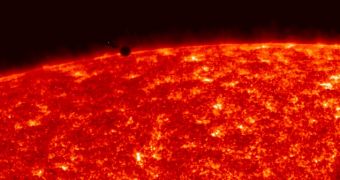More than 33 years after the last fly-by around the smallest planet in the solar system, made by the Mariner 10 spacecraft, NASA's MESSENGER spacecraft executed its first fly-by around Mercury on the 14th of January. During this first close encounter, MESSENGER had the mission of taking multiple pictures of Mercury's surface and vast land areas unseen before. In fact, more than half of the surface of the planet is not mapped yet.
The fly-by made on 14 January took the MESSENGER spacecraft to 200 kilometers only over the surface of the planet, in order to make the first detailed measurements ever since Mariner 10's last fly-by on the 16th of March 1975. Aside the scientific value presented by this gravitational assisted maneuver, the fly-by will also redirect the spacecraft into a trajectory that will eventually take it into the orbit around the planet by the year 2011.
In the meantime, MESSENGER's Fast Imaging Plasma Spectrometer made measurements on Mercury's atmosphere in order to determine its composition and the interactions which take place between it and the space environment, under the action of the solar winds.
Except the fact that it is a rocky planet and it presents a magnetosphere, Mercury has very little features in common with our planet. Its orbit taking it close to the Sun determines Mercury to receive a massive amount of radiation and heat. Unlike the Earth, which has a thick atmosphere, Mercury cannot stop particle radiations by absorbing them into the atmosphere, so they fall right down onto the surface of the planet.
The weak magnetic field of the planet is generated by a massive iron core which represents more than two-thirds of the planets mass. Again, the Earth is protected against the energetically charged particles from the solar wind by the powerful magnetic field which bounces them right back into space. Such a small planet should have solidified its molten iron core a long time ago, but the presence of the magnetic field suggests otherwise.
Almost nothing is known about its thin atmosphere, thus its component gases. Most of the scientific community argues that Mercury's atmosphere is most likely formed of a mix of sodium, potassium and oxygen gas. However, until the data is analyzed, astronomers do not have the slightest clue about what really makes its atmosphere.

 14 DAY TRIAL //
14 DAY TRIAL //